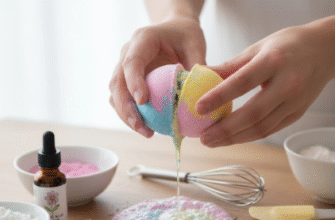There’s something undeniably special about sinking into a warm bath after a long day. The heat soaks into tired muscles, the steam rises, and for a precious few moments, the world outside seems to melt away. It’s a simple ritual, yet profoundly restorative. But what if you could elevate this personal sanctuary even further? What if you could transform a pleasant soak into a truly immersive escape? The answer might be simpler than you think: just add music.
Music possesses an almost magical ability to tap directly into our emotional core. A familiar melody can transport us back in time, a soaring orchestral piece can fill us with awe, and a gentle tune can soothe a frayed nervous system. When combined with the physical relaxation of a warm bath, the right soundtrack can create a powerful synergy, washing away stress not just from the body, but from the mind as well.
The Science of Sound and Serenity
Why does music have such a profound effect on our relaxation? It’s partly physiological. Calming music, often characterized by slower tempos, predictable rhythms, and lower frequencies, can actually influence our physical state. Studies suggest listening to relaxing music can help slow the heart rate, lower blood pressure, and decrease levels of stress hormones like cortisol. It encourages the body to shift from the ‘fight or flight’ response triggered by daily stressors to the ‘rest and digest’ state, which is essential for true relaxation and recovery.
Beyond the purely physical, music engages the brain in ways that actively combat mental clutter. When you focus, even passively, on the melodies and harmonies, it gives your mind something pleasant to anchor to, preventing stressful thoughts or worries from intruding. It’s like a gentle mental massage, smoothing out the wrinkles of the day and allowing you to be fully present in your moment of peace.
Crafting Your Perfect Bath Time Playlist
The “right” music for a relaxing bath is, of course, deeply personal. What one person finds soothing, another might find dreary. However, certain genres and styles consistently lend themselves well to creating a tranquil atmosphere.
Classical Calm
You don’t need to be a classical music aficionado to appreciate its calming potential. Look for pieces known for their gentle dynamics and flowing melodies. Think of the impressionistic dreaminess of Debussy’s “Clair de Lune,” the minimalist serenity of Erik Satie’s “Gymnopédies,” or the slow movements from Baroque composers like Bach or Handel. Avoid bombastic symphonies or dramatic operas; focus on chamber music, solo piano, or gentle orchestral suites.
Ambient and Chillout Soundscapes
This genre is almost purpose-built for relaxation. Ambient music often features atmospheric textures, evolving soundscapes, and a lack of prominent beats or vocals. It’s designed to create a mood rather than demand your full attention. Artists like Brian Eno (considered a pioneer of ambient), Marconi Union (famous for “Weightless,” often cited as one of the most relaxing tracks ever recorded), or modern chillout electronic artists can provide a seamless sonic blanket, perfect for drifting away.
Nature’s Own Soundtrack
Sometimes, the most relaxing sounds aren’t “music” in the traditional sense. High-quality recordings of nature sounds can be incredibly effective. Imagine soaking while listening to the gentle patter of rain on leaves, the rhythmic ebb and flow of ocean waves, the soft crackling of a campfire, or the distant song of birds. These sounds connect us to the natural world, triggering primal feelings of safety and peace.
Instrumental and Acoustic Melodies
Often, lyrics can inadvertently pull your mind back to specific thoughts or narratives. Instrumental music bypasses this entirely. Gentle acoustic guitar, soft jazz piano, lyrical cello pieces, or even calming instrumental folk tunes can provide beautiful melodies without the distraction of words. Look for artists known for their delicate touch and soothing compositions.
Your Personal Comfort Zone
Don’t discount the power of familiarity. If there’s a particular album or artist (even one with vocals) that you personally associate with comfort, calm, and happy memories, it might be the perfect choice for your bath, provided it maintains a generally relaxed tempo and feel. The emotional connection can be just as powerful as the inherent qualities of the music itself.
Optimizing Your Audio Experience
Simply pressing play isn’t quite enough. A few considerations can make your musical bath even better.
Speaker Choice and Safety: Water and electronics don’t mix well! Never place a non-waterproof device like your phone or a standard speaker on the edge of the tub. The safest option is a dedicated waterproof Bluetooth speaker designed for use in wet environments. Alternatively, place a regular speaker safely across the room, ensuring it’s far from any potential splashes.
Important Safety Note: Always prioritize safety when using electronics near water. Ensure any speaker used is either certified waterproof and placed securely, or kept well away from the bath to prevent any risk of electric shock or damage to your device. Never handle plugged-in devices while wet.
Volume Levels: The goal is relaxation, not a rock concert. Keep the volume moderate to low. The music should be a background element that enhances the atmosphere, not dominates it. It should gently envelop you, not blast at you. You want to be able to hear the soft splash of water and your own quiet breathing.
Playlist Preparation: Fumbling with your phone or speaker mid-bath can break the spell. Create a playlist beforehand that’s long enough to last your entire soak. This ensures a continuous flow of calming sound without interruption. Consider using streaming services that offer pre-made relaxation or spa playlists if you’re unsure where to start.
Beyond Sound: Engaging All Senses
Music is powerful, but it works best as part of a multi-sensory relaxation experience. Enhance your musical bath by:
- Dimming the Lights: Soft, low lighting is much more conducive to relaxation than harsh overhead lights. Use candles (safely placed, of course) or a dimmable lamp.
- Adding Scents: Incorporate calming scents through bath oils, bath bombs, or an essential oil diffuser (placed safely away from water). Lavender, chamomile, sandalwood, and bergamot are popular choices for relaxation.
- Temperature Control: Ensure the water temperature is comfortably warm, but not scalding hot.
When you combine the soothing sounds of music with pleasant scents, soft lighting, and warm water, you create a holistic relaxation ritual that nurtures both body and mind.
A Simple Upgrade for Profound Results
Adding music to your bath time isn’t a complicated life hack. It’s a simple, accessible way to significantly deepen your relaxation. It helps drown out the mental noise of the day, encourages your body to release tension, and transforms a routine soak into a luxurious escape.
Verified studies consistently show that listening to music can positively influence mood and reduce perceived stress levels. Specific types of music, particularly those with slow tempos and without jarring changes, are often linked to increased feelings of calmness and well-being. This effect is believed to be connected to music’s impact on brain activity and hormone regulation.
Think about the kind of atmosphere you want to create. Do you want to feel like you’re floating in a serene spa? Choose ambient or classical pieces. Do you want to feel connected to nature? Opt for rain sounds or ocean waves. Do you just want to sink into familiar comfort? Put on that gentle acoustic album you love.
So next time you run the tap, take an extra minute to select some calming tunes. Experiment with different genres and artists until you find what resonates most deeply with you. You might be surprised at how profoundly this simple addition can enhance your precious moments of peace and quiet, turning your bathroom into a personalized haven of tranquility. Let the water wash away your physical stress, and let the music soothe your soul.








